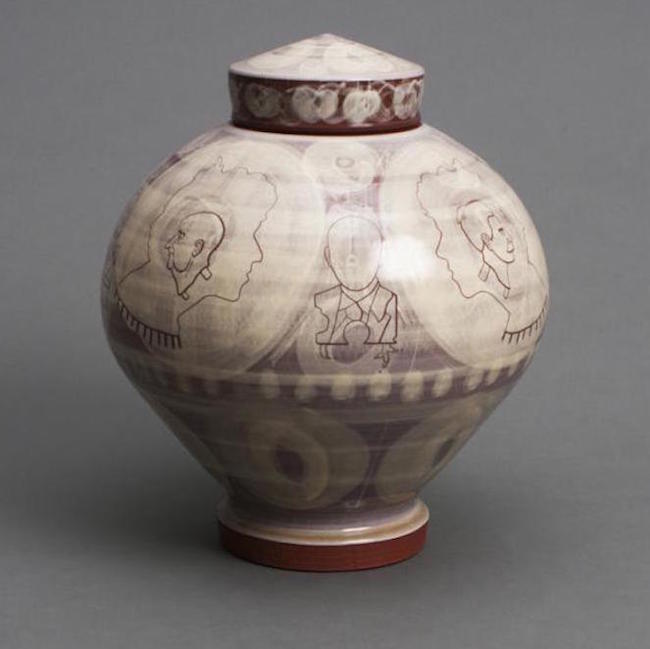Perhaps another sign of ceramics coming into its own is that more and more people would rather spend eternity in a vessel as opposed to a box buried underground. A lot has been written about the rise in cremation recently; it’s the fastest-growing trend in funerals. There are many reasons cited for this. For example, the cost of a burial has increased almost ten times over the last few decades. We’re also more mobile as a society, meaning your family is less likely to leave you in a cemetery plot thousands of miles away.
Above image: Daniel Ricardo Teran, “Almost” Urn, 2014, earthenware, 10 x 10 x 12 inches, $950
The Clay Studio of Philadelphia recently wrapped up an exhibition of urns in which artists were invited to make a vessel that contains their thoughts about death and dying. Eight artists (Adam Posnak, Kurt Anderson, Molly Anne Bishop, Jason Hess, Heesoo Lee, Daniel Ricardo Teran, Peter Olson and Mitch Lyons) participated in the exhibition and several of the ceramists explained their work. We’re running their thoughts here. Visit The Clay Studio for information on purchasing.

Peter Olson, Adams and Eves, 2015, stoneware, 5 x 5 x 15 inches, $650

Peter Olson, Repetition and Motion, 2015, stoneware, 7 x 7 x 14 inches, $600
My ceramic works begin with my experiences as a photographer, and transform into self-contained meditations on movement and the human relationship to imagery. The vessels give the images a place to exist, and I explore themes in each that are allowed to take form with detailed collaging.
The art historical images in Adams and Eves repeat in pairings of alternating genders, the whole piece is simply about couples and relationships between people. With my photographs, I treat contemporary life equally with my captured images of art and architecture, as the images cohabit in our imaginations.
Repetition and Motion reflects on the infinite moments of daily life. We remember specific instants of action in our own lives, less so the constant movement of others in our periphery. Observing these seemingly endless human routines of city life, the images of perpetual motion culminate in a circular form.

Molly Anne Bishop, Jar, 2015, terracotta, 7.5 x 7.5 x 10 inches, $250
Urns as objects are symbolic, sacred, and often quite serious. The urn I made for this show is a playful take on the usually somber vessel. I was inspired by the importance of the urn in ceramic history and the mystery that is inherent in a vessel connected with a final resting place.

Adam Posnak, Large Jar, 2015, stoneware, 10 x 10 x 12.5 inches, $300

Adam Posnak, Jar, 2015, stoneware, 8 x 8 x 10 inches, $200
The two jars’ surface imagery reference the African-Atlantic cosmological understanding that the souls of deceased ancestors, as well as the animate spirits on the natural world, reside in the wilderness. The relationship and boundary between urban space and the unmitigated wild is understood to be the same margin between the land of the living and the realm of the ancestors. These “lands” are known to be inverse mirror images, such that noon in the land of the living is midnight in the ancestral abode.

Adam Posnak, Large Jar (alternate view).
Both jars feature tree imageries that specifically reference the Ceiba treem venerated in African –Caribbean tradition. The smaller jar quotes the words of a Cuban-Kongo song “Ceiba, Ceiba, dame tu sombra, Ceiba,” which translates “Ceiba, Ceiba, give me your shade, Ceiba.”

Adam Posnak, Large Jar (alternate view).

Adam Posnak, Jar (alternate view).
This song of supplication and praise, for the tree that is thought to be of a particular spiritual potency, and which cradles the souls of the deceased.


Kurt Anderson, Pussy/Money/Weed, 2015, porcelain, 8.5 x 8.5 x 12 inches, sold
You’re going to be in here for a long time (well what’s left of you) so you might as well surround yourself with a few of the things you found comfort in while living.

Heesoo Lee, Wave Urn, 2015, porcelain, 6.5 x 6.5 x 10.5 inches, $520
My approach to the challenge of creating an urn for Memories and Mourning was to take a closer look at some possible counterpoints to loss and death. New life, nurturing, tranquility, strength, and growth are themes I explored in creating my urn. I find the ocean to be a well suited metaphor for loss and life.
Love contemporary ceramic art + design? Let us know in the comments.

Mitch Lyons, Bingo, 2015, stoneware, 4.5 x 10 x 10.5 inches, $450

Jason Hess, Urn, 2015, porcelain, 8.5 x 8.5 x 8.5 inches, $245


Daniel Ricardo Teran, “Almost” Urn, 2014, earthenware, 10 x 10 x 12 inches, $950

Add your valued opinion to this post.